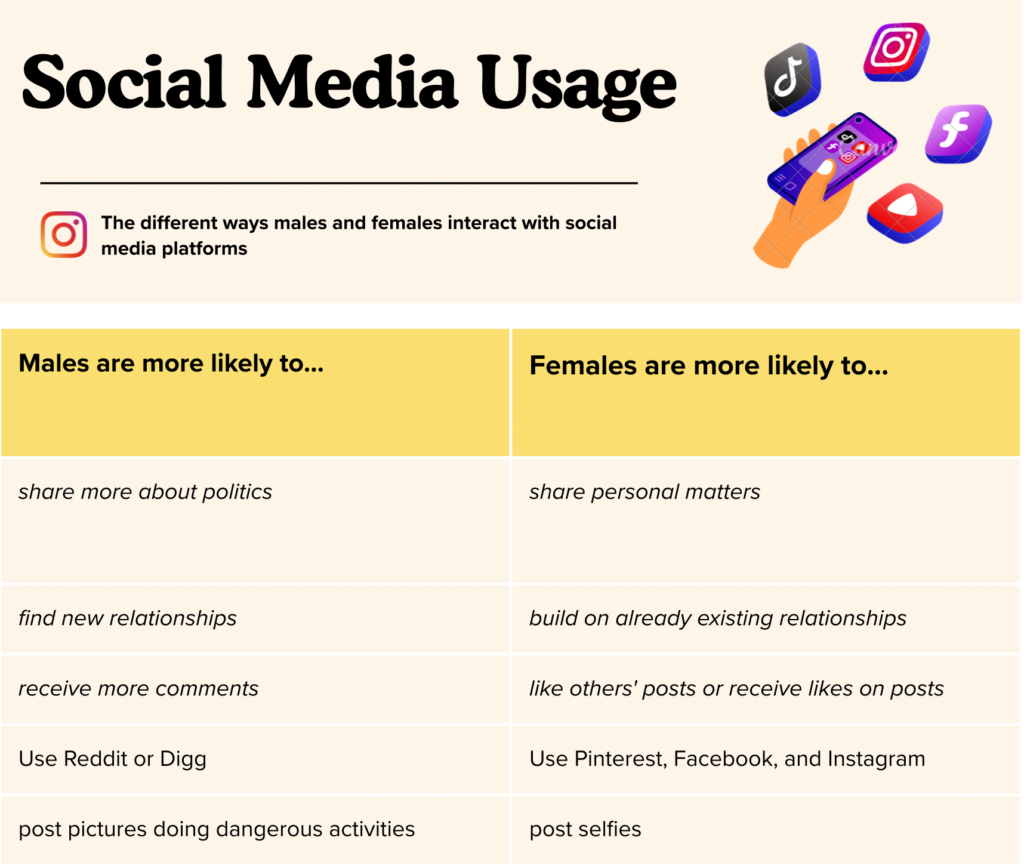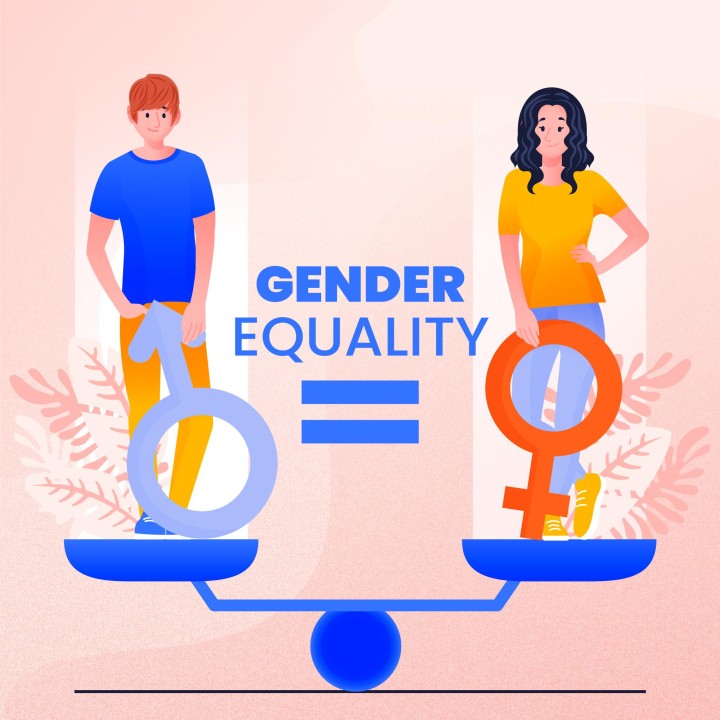Overview
Staying up to date and being constantly connected are some of the reasons why engagement in social media is a “way of being” rather than a mere activity. In today’s world social media usage has become a norm for both men and women. However, the way they use social media differs. Men create social media accounts such as Instagram or Facebook to look for new relationships compared to Women who use the same platform to create and use these accounts to sustain already existing relationships. It is also shown that men and women often engage in different topics. According to a Facebook investigation, women are more likely to disclose personal information on the social media platform, including family affairs. Men, on the other hand, talk about things like sports. Results showed that not only did men and women have distinct themes that they want to talk about, but that obviously “male” issues (sports, for example) receive more comments from other users while seemingly “female” topics (birthdays, family time) receive more likes. Negative feedback is one of the reasons why female users could be more reserved on the internet. When women voice their ideas, they often receive more derogatory remarks. For example in this Twitter experiment conducted by British journalist Martin Belam – Belam created a spoof account in which he pretended to guest-tweet as different male and female celebrities. When he presented himself as a woman, the account received significantly more offensive comments, and even blatantly misogynist ones. The preferred social media platform for men and women will also differ based on the topics they enjoy discussing online. Men tend to use more text-oriented platforms, whereas women typically favor visual ones. More women use Pinterest, Facebook, and Instagram than men do, while more men use online discussion sites like Reddit or Digg. Sociologist Katrin Tiidenberg of Tallinn University thinks the solution can be found in the traditional role in the family: moms have always taken more family portraits compared to dads. This may also contribute to the explanation of why women upload more selfies than men: the Selfie Exploratory project, for instance, examined 3800 Instagram photos from five different cities worldwide and discovered that there are consistently many more female selfies than male selfies. Younger users exhibit even more marked distinctions from this group; numerous studies have revealed that teenagers frequently construct their social media profiles around gender norms. Teenage boys are more likely to share images of themselves engaging in dangerous activities, drinking, or having sex, whereas girls are more likely to share overtly seductive photos of themselves.

Policy Intervention
Policy intervention in the realm of social media is a challenging topic. One of the main issues involving social media is hate speech. As we saw above women are more prone to receive hurtful comments or interactions from other users compared to men. However, that does not mean a man can’t receive hate on social media platforms. Social media platforms aiming to monitor speech are tasked with a slippery slope concerning the freedom of speech. However, it is their job to review and detect hate speech. For example, In 2016, a group of major tech companies agreed upon the European Commission’s Code of Conduct on Countering Illegal Hate Speech Online, which requires these companies to review hateful speech within a day of receiving a report. This approach is challenging due to high variance in terms of service and operational definitions of hate speech, but it is a significant effort in promoting collaboration and linking legal approaches in the hate speech space. This policy is a step in the right direction but the problem still lies that companies need someone to report an issue of hate speech before the hate speech is investigated. With the technology available today social media companies should be able to monitor their platform more easily finding hate speech before it is reported. This type of policy intervention can be seen in a 2021 report by YouTube and Facebook who both reported a rise in the amount of content they detected and flagged, as well as a higher percentage of content that was flagged by the companies versus by users. This is because automated detection technologies are being used more and more. Because social media companies are not subject to territorial jurisdiction, it is crucial to remember that their obligations are limited to adhering to their terms of service, which may or may not be more stringent than the guidelines established by the international agreements mentioned above.
Potential Consequences Without Intervention
Potential consequences without intervention include an increased amount of hate speech going undetected and affecting young minds poorly. There is a greater chance that hate speech on the internet will manifest as physical violence if laws banning it are ineffective.. Hate speech has the potential to escalate into hate crimes against specific individuals or groups by normalizing discriminatory beliefs. This can be seen in the widespread use of social media During the January 6, 2021 attack on the capital. Hate speech has the power to polarize people and widen already existing societal divides. Without controls, social media sites could serve as havens for radical ideologies, escalating hostility and conflict between various communities. Hate speech frequently manifests as cyberbullying and harassment, fostering an aggressive atmosphere for those singled out for discrimination based on gender, race, or other attributes. Psychological distress, emotional pain, self-harm, or suicide, can result from this. Finally, social media companies risk damage to their brand if they ignore hate speech. When harmful material is allowed to spread on platforms, users may lose faith in those platforms, which results in a drop in user activity and perhaps legal issues.
Sources
Atanasova, A. (2016, November 6). Gender-specific behaviors on social media and what they mean for online communications. Social Media Today. https://www.socialmediatoday.com/social-networks/gender-specific-behaviors-social-media-and-what-they-mean-online-communications#:~:text=An%20investigation%20conducted%20by%20Facebook,the%20platform%2C%20categorizing%20them%20into
Belam, M. (2013, July 4). How my spoof BBC question time twitter account showed me the level of abuse political women face on social media. martinbelam.com. https://martinbelam.com/2013/bbcextraghost/
Gender, topic, and audience response: An analysis of user-generated content on Facebook – Meta Research. Meta Research. (n.d.). https://research.facebook.com/publications/gender-topic-and-audience-response-an-analysis-of-user-generated-content-on-facebook/
Herring, S. C. (n.d.). Teens, gender, and self-presentation in social media. https://homes.luddy.indiana.edu/herring/teens.gender.pdf
Selfiexploratory. (n.d.). https://selfiecity.net/selfiexploratory/
Seligson, H. (2016, June 7). Why are more women than men on Instagram?. The Atlantic. https://www.theatlantic.com/technology/archive/2016/06/why-are-more-women-than-men-on-instagram/485993/
United Nations Office on Genocide Prevention and the Responsibility to Protect [24]. (2021). Addressing hate speech on social media: contemporary challenges. Unesdoc.unesco.org. https://unesdoc.unesco.org/ark:/48223/pf0000379177

